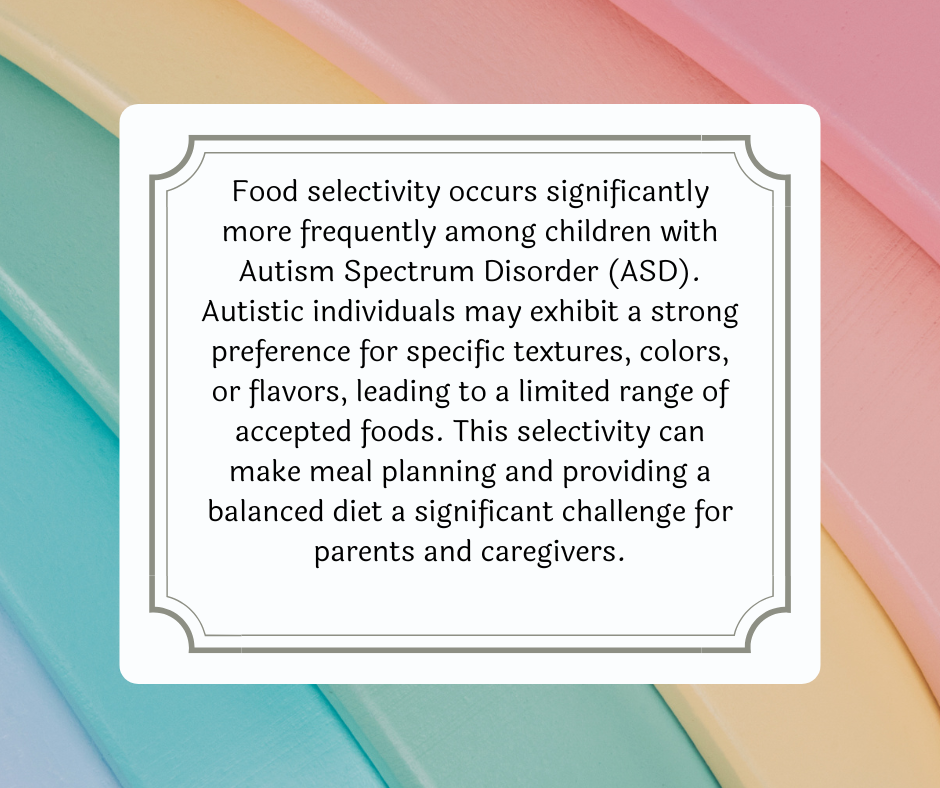Autism can have a profound impact on the eating habits of individuals on the spectrum. From food selectivity to gastrointestinal issues, it’s important to understand the challenges that can arise in relation to autism and food.

Research Insights on Autism and Eating
Understanding the relationship between autism and eating behaviors is essential for developing effective strategies to manage food preferences in individuals with autism. Ongoing research is shedding light on various aspects of autism and its connection to eating behaviors. In this section, we will explore the link between autism and overeating as well as behavioral therapy approaches for managing food-related challenges.
Link Between Autism and Overeating
Research conducted by Greg Wallace, an assistant professor of speech, language, and hearing sciences, aims to investigate a possible autism-related eating irregularity, a.k.a. overeating. While children with autism are more likely to be “picky” eaters, paradoxically, they are also more likely to be obese. Wallace’s work focuses on understanding the connection between overeaters and selective eaters to develop better behavioral therapy solutions for both groups.
A pilot study conducted by Wallace, funded by a $25,000 grant from the Maternal and Child Health Research Program of the U.S. Department of Health and Human Services, aims to determine if children with ASD are more likely to be rated as overeaters compared to typically developing children. The study progresses to in-person testing to examine any cognitive underpinnings of a possible increased propensity to overeat.
Preliminary findings from Wallace’s research indicate a potential link between overeating in children with autism and difficulties in behavioral flexibility. This includes struggling to shift between tasks or settings. This connection may help explain the association of autism with selective eaters, who often show greater inflexibility. It is possible that there is even a subset of individuals with autism who are both selective eaters and overeaters.
While these findings provide insight into the complex relationship between autism and overeating, further research is needed to fully understand the underlying mechanisms. Discovering connections between different aspects of autism, such as eating behaviors, may lead to potential breakthroughs in research and therapy. Cognitive behavioral therapy, which has shown success with selective eaters, could potentially be modified to create a similar program for overeaters. However, it is important to note that firm conclusions are still far from being reached due to the individual nature of autism.

Behavioral Therapy Approaches
Behavioral therapy approaches have shown promise in managing food-related challenges in individuals with autism. These approaches aim to address the underlying factors contributing to food selectivity and overeating behaviors.
Applied Behavior Analysis (ABA) is a commonly used behavioral therapy approach for individuals with autism. It focuses on identifying the antecedents and consequences of eating behaviors and implementing strategies to modify them. This may involve using visual supports, structured mealtime routines, and gradually introducing new foods through systematic desensitization.
Another approach is Cognitive Behavioral Therapy (CBT), which focuses on identifying and modifying negative thoughts, emotions, and behaviors associated with food and eating. CBT can help individuals with autism develop coping strategies for managing anxiety or sensory sensitivities related to food.
In addition to these therapeutic approaches, a multidisciplinary approach involving healthcare professionals, including speech therapists, occupational therapists, and dietitians, can provide comprehensive support in managing food-related challenges in individuals with autism.
By further exploring the link between autism and eating behaviors and utilizing behavioral therapy approaches, parents and caregivers can develop effective strategies to navigate food preferences and help individuals with autism develop healthier relationships with food.
Impact of Autism on Eating Habits
Feeding and eating problems are commonly observed in children, with around 10-20% experiencing such difficulties. However, parents of autistic children report this problem at a much higher rate, with at least 70% of autistic children facing challenges in their eating habits. These difficulties can manifest in various ways, such as refusing certain foods, limited food preferences, or difficulty transitioning to new foods.

Food Selectivity in Autistic Children
To better understand and manage food selectivity in autistic children, it’s important to consider their sensory sensitivities. Autistic individuals may have heightened sensory responses, which can affect their perception of taste, texture, and even the smell of food. These sensory sensitivities can contribute to their selectivity and preferences.
By working closely with healthcare professionals, such as occupational therapists or registered dietitians, parents and caregivers can develop strategies to address food selectivity and expand the variety of foods in an autistic child’s diet. These strategies may include gradually introducing new foods, incorporating preferred foods into meals, or using visual supports to help with food exploration.
Challenges with Food and Autism
There are several unique challenges with food that individuals on the autism spectrum may face. Understanding these challenges is vital for parents and caregivers in order to provide appropriate support and management strategies. In this section, we will explore three key challenges related to food and autism: gastrointestinal issues, fine motor skills, and technology use in meal times.
Gastrointestinal Issues in Autism
More than 50 percent of autistic children experience gastrointestinal problems such as Crohn’s Disease or colitis, indicating a significant correlation between autism and gastrointestinal issues. These digestive problems can range from mild to severe and may contribute to difficulties with eating and food selectivity. It is important for parents and caregivers to be aware of these issues and work closely with healthcare professionals to address and manage them effectively.
Fine Motor Skills and Eating
Autistic individuals may have challenges with fine motor skills, which can affect their ability to handle utensils and eat independently. Difficulties with swallowing, coordination, and dexterity can make it challenging for them to use utensils efficiently. This can lead to frustration and a reluctance to engage in self-feeding. It is important to work on developing these skills through occupational therapy and other interventions to promote independence in eating. Providing adapted utensils or exploring alternative eating techniques can also be helpful in improving their mealtime experience.

Technology Use in Meal Times
Research has shown that autistic children consume meals with the use of high technology devices twice as frequently as their neurotypical peers. While technology can provide certain benefits, such as visual schedules and social stories to support mealtime routines, excessive reliance on screens during meals can also have negative implications. Excessive screen time can lead to decreased social interactions and can disrupt the development of healthy eating habits. It is important for parents and caregivers to find a balance and set boundaries around technology use during meal times to promote engagement and social interaction.
Understanding and addressing these challenges can greatly improve the dining experience for individuals on the autism spectrum. By working closely with healthcare professionals and implementing appropriate strategies, parents and caregivers can help individuals with autism develop healthier eating habits and overcome these challenges.
Nutritional Concerns
When it comes to individuals with autism, there are specific nutritional concerns that need to be addressed along with the provision of ABA Therapy Services. These concerns include nutritional deficiencies and weight management challenges. Understanding and managing these concerns is crucial for promoting the overall health and well-being of individuals with autism.
Nutritional Deficiencies in Autism
Many individuals with ASD tend to have a strong preference for processed foods and carbohydrates while rejecting fruits and vegetables. This can lead to nutritional deficiencies, especially if their diet lacks a variety of essential nutrients. Common deficiencies among individuals with autism include vitamins, minerals, and omega-3 fatty acids.
To address nutritional deficiencies, it is important to work with a healthcare professional to develop a balanced and nutrient-rich diet plan. Including a wide range of fruits, vegetables, lean proteins, whole grains, and healthy fats can help ensure that individuals with autism are receiving the necessary vitamins and minerals for optimal health.
Weight Management Challenges
Weight management can be a challenge for individuals with autism, particularly due to their food preferences and limited exercise. Many individuals with autism have a strong preference for carbohydrates and processed foods, which tend to be higher in calories and lower in nutritional value. Combined with limited physical activity, this can lead to excessive weight gain.
It’s important to address weight management challenges in a sensitive and supportive manner. Encouraging regular physical activity and providing opportunities for exercise can help individuals with autism maintain a healthy weight. Additionally, working with a healthcare professional or a registered dietitian can provide guidance on portion control, healthy food choices, and meal planning to support weight management.
Strategies for Managing Food Preferences
When it comes to managing food preferences in individuals with autism, there are specific strategies that can help promote a varied and balanced diet. It’s important to remember that each person with autism is unique, and what works for one individual may not work for another. In this section, we will explore two key strategies: introducing new foods and addressing sensory sensitivities.
Introducing New Foods
Introducing new foods to individuals with autism can be a gradual process that requires patience and persistence. The need for sameness, which is common in individuals with autism, can make it challenging to introduce new foods into their diet. Unexpected changes can upset them, making mealtimes emotionally loaded for the entire family. However, with a strategic approach, it is possible to expand their food preferences.
One effective technique is the “food chaining” method. Food chaining involves gradually introducing new foods that are similar in taste, texture, or appearance to foods that the individual already enjoys. For example, if the individual enjoys mashed potatoes, you can gradually introduce other types of mashed vegetables like sweet potatoes or carrots. This method helps to reduce anxiety and resistance to new foods while allowing for a gradual expansion of their diet.
It’s also important to involve the individual in the process of selecting and preparing new foods. This can include taking them grocery shopping, allowing them to choose a new fruit or vegetable, and involving them in the cooking or meal preparation. By engaging them in the process, they may feel more ownership and be more willing to try the new foods.
Addressing Sensory Sensitivities
Research indicates that individuals with autism often have extreme sensitivity to change and sensory stimuli, along with an intense focus on details. This can manifest in strong preferences for a narrow selection of foods and specific eating habits. Addressing sensory sensitivities is crucial in managing food preferences.
To address sensory sensitivities, it’s important to understand the specific sensory issues that the individual may have. For example, some individuals may have sensitivities to certain textures, smells, or tastes. By identifying and accommodating these sensitivities, you can make mealtimes more comfortable and enjoyable for them.
One approach is to gradually expose the individual to new textures or tastes in a controlled and supportive environment. This can involve introducing new foods in small quantities, allowing them to touch or smell the food before tasting it, or offering a preferred food alongside a new food to make it more familiar.
Creating a calm and sensory-friendly eating environment can also help. Minimizing distractions, such as loud noises or strong smells, can reduce sensory overload during meals. Providing a designated space for eating that is comfortable and familiar can also contribute to a more positive eating experience.
By implementing strategies such as introducing new foods and addressing sensory sensitivities, caregivers can help individuals with autism expand their food preferences and develop a more varied and balanced diet. It’s important to seek guidance from healthcare professionals, such as dietitians or therapists, who specialize in autism and can provide tailored recommendations and support.

